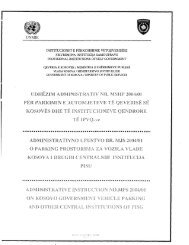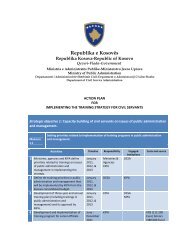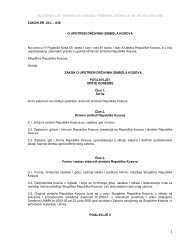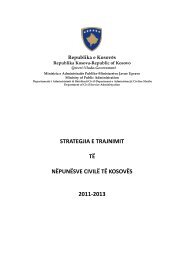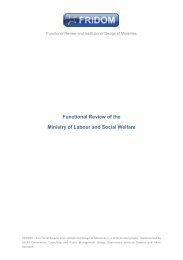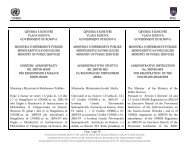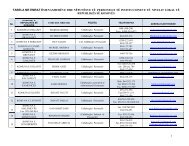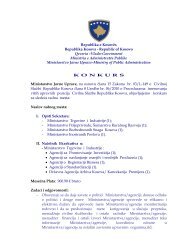Functional Review of the Ministry of Environment and Spatial Planning
Functional Review of the Ministry of Environment and Spatial Planning
Functional Review of the Ministry of Environment and Spatial Planning
Create successful ePaper yourself
Turn your PDF publications into a flip-book with our unique Google optimized e-Paper software.
SECTION II: CROSS-CUTTING FINDINGS AND RECOMMENDATIONS<br />
In this section, we present a set <strong>of</strong> findings <strong>and</strong> resulting recommendations that concern <strong>the</strong> functioning <strong>of</strong><br />
<strong>the</strong> <strong>Ministry</strong> as a whole. Their purpose is to improve <strong>the</strong> performance <strong>of</strong> <strong>the</strong> MESP as an institution largely<br />
through changes in organization as well as processes <strong>and</strong> HR management. The text does not provide a<br />
comprehensive analysis <strong>of</strong> each country’s ministry <strong>of</strong> environment, but ra<strong>the</strong>r focuses on topics important<br />
for Kosovo’s MESP. It illustrates how things are organized elsewhere, <strong>and</strong> through <strong>the</strong>se examples draws<br />
recommendations for actions in <strong>the</strong> context <strong>of</strong> Kosovo. All <strong>of</strong> <strong>the</strong>se recommendations have a general<br />
character - department specific recommendations can be found in Section III <strong>of</strong> this report.<br />
The fundamental functions <strong>of</strong> <strong>the</strong> MESP as a representative <strong>of</strong> public administration are <strong>the</strong> following key<br />
groups: i) policy function; ii) regulatory function; iii) executive (implementation, management) function <strong>and</strong><br />
iv) service delivery to clients function.<br />
An examination <strong>of</strong> <strong>the</strong> environmental functions derived from <strong>the</strong> EU acquis, i.e. policy – law – permitting –<br />
monitoring – inspection – enforcement – information – research – international co-operation shows that <strong>the</strong>y<br />
are compatible <strong>and</strong> consistent with <strong>the</strong> key functions mentioned above.<br />
II. 1 Current organizational structure <strong>of</strong> <strong>the</strong> ministry<br />
MESP consists <strong>of</strong> six major departments, each dealing with one, department <strong>of</strong> housing <strong>and</strong> construction<br />
with two <strong>and</strong> department <strong>of</strong> environment protection with six <strong>of</strong> <strong>the</strong> major areas, with additional units for<br />
support <strong>and</strong> cross-cutting as well as management <strong>of</strong> <strong>the</strong> <strong>Ministry</strong>. Corporate, executive <strong>and</strong> supportive<br />
hierarchy is clearly defined. The <strong>Ministry</strong> is also responsible for four institutions in <strong>the</strong>se areas – Kosovo<br />
<strong>Environment</strong> Protection Agency (KEPA) including Institute for Nature Conservation <strong>and</strong> Kosovo<br />
Hydrometeorological Institute (KHMI), Kosovo Cadastral Agency (KCA) <strong>and</strong> Institute for <strong>Spatial</strong> <strong>Planning</strong><br />
(ISP).<br />
Scheme 1. Unveiled functional shortcomings at MESP<br />
Political cabinet<br />
Uncertain function - tasks,<br />
responsibilities<br />
Mixing <strong>of</strong> inspection <strong>and</strong><br />
decision making<br />
Department for<br />
<strong>Environment</strong> Protection<br />
Department for <strong>Spatial</strong><br />
<strong>Planning</strong><br />
Institute for spatial<br />
planning<br />
Deputy Minister<br />
Minister<br />
Inspectorate for<br />
environment <strong>and</strong> water<br />
Permanent<br />
Secretary<br />
First <strong>of</strong> all, based on <strong>the</strong> analysis <strong>of</strong> <strong>the</strong> existing organization structure, consultants found a strong<br />
fragmentation within <strong>the</strong> MESP – what is generally called a silo mentality, where departments dealing with<br />
each policy field have little contact <strong>and</strong> coordination with <strong>the</strong> rest <strong>of</strong> <strong>the</strong> ministry. This creates a lack <strong>of</strong><br />
12<br />
Office for international<br />
cooperation <strong>and</strong> EU<br />
integration<br />
PR <strong>and</strong> Information Office Internal Audit Office<br />
Department for housing<br />
<strong>and</strong> construction<br />
Eko Fund<br />
Department for Water<br />
Not adopted yet<br />
Office for gender <strong>and</strong><br />
ethnic equality<br />
<strong>and</strong> human rights<br />
Department <strong>of</strong> central<br />
administration<br />
Too large span <strong>of</strong> control problem<br />
& decisions to h<strong>and</strong>le<br />
Institute for hydro<br />
meteorology<br />
Kosovo Agency for<br />
<strong>Environment</strong> Protection<br />
Management <strong>of</strong> National<br />
Parks<br />
Institute for nature<br />
conservation<br />
Uncertain function - tasks,<br />
responsibilities<br />
Mixing <strong>of</strong> decision making<br />
<strong>and</strong> operation<br />
Procurement



